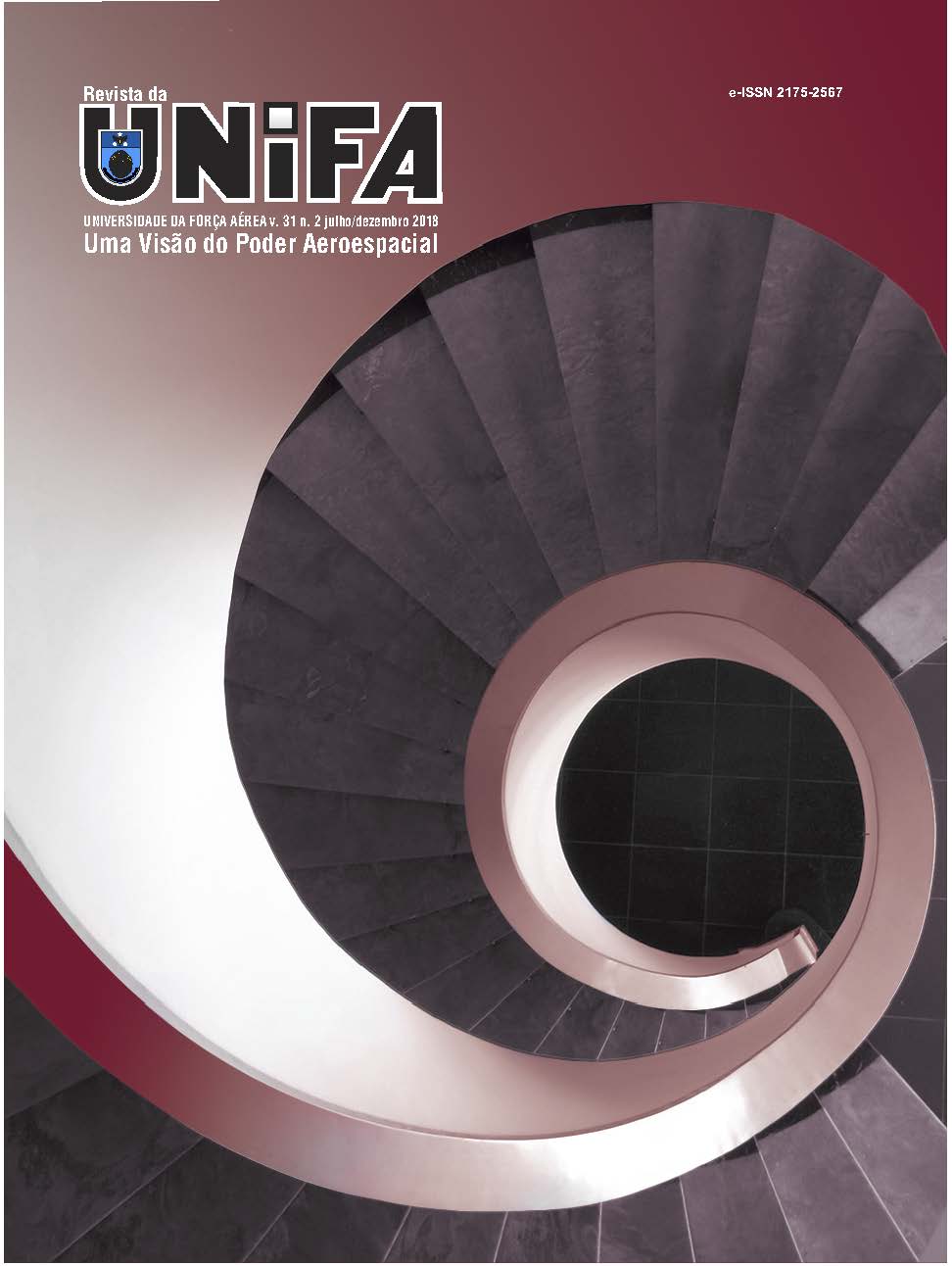The influence of air activity removal on the performance an F-5M pilot
DOI:
https://doi.org/10.22480/revunifa.2018.31.481Keywords:
Removal, Airborne activity, Performance, F-5MAbstract
This scientific paper proposes to assess to what extent the time away longer than 90 days influences the performance of expert pilots of the F-5M aircraft in airborne visual combat missions. As a theoretical basis, we used the studies by Mager and Pipe (1979) on performance problems and Stillon (1999) on the skills of fighter pilots in the USAF. Thus, the skills required for the F-5M pilot in the WVR missions were identified in the research of Fórneas (2015). Later, in order to identify which skills are affected when the F-5M pilot is removed for more than 90 days from the WVR missions, a five-point Likert scale questionnaire (1932) was forwarded to 39 pilots from three F-5M FAB Squadrons that remained more than 90 days without flying this type of mission in the years of 2016 and 2017. The skill degradation was analyzed in two ways: as a set and separated by general skills and air-air (BIGELOW et al., 2003). Likewise, the pilots were analyzed in groups and separated by experience levels. The results indicated the need to establish new limits for the training frequency. Thus, the conclusions obtained by this work will serve as a basis for future decisions about the training of fighter pilots and the consequent maintenance of the skills obtained in the initial trainings, being useful even to the formulation of the F-39 - Gripen training program.
References
BIGELOW, J. H.; TAYLOR, W. W.; MOORE, S. C.; THOMAS, B. Models of Operational Training in Fighter Squadrons. Rand Research Institute: Santa Monica, CA, 2003. Disponível em: https://www.rand. org/content/dam/rand/pubs/monograph_reports/2005/ MR1701.pdf Acesso em: 05 ago. 2017.
BRASIL. Comando da Aeronáutica. Estado Maior da Aeronáutica. Portaria GABAER nº 189/GC3, de 30 de janeiro de 2017. Aprova a 1ª modificação da DCA 11-45 “Concepção Estratégica Força Aérea 100”. Boletim do Comando da Aeronáutica, Rio de Janeiro, n. 18, f. 1058, 01 fev. 2017.
BRASIL. Decreto Legislativo nº 373, de 25 de setembro de 2013. Aprova a Política Nacional de Defesa, a Estratégia Nacional de Defesa e o Livro Branco de Defesa Nacional, encaminhados ao Congresso Nacional pela Mensagem nº 83, de 2012 (Mensagem nº 323, de 17 de julho de 2012, na origem). Diário Oficial [da] República Federativa do Brasil, Brasília, DF, 2013. Disponível em: < http://www.defesa.gov.br/ arquivos/2012/mes07/end.pdf >. Acesso em: 20 ago. 2017.
COCHRAN, W. G. Técnicas de amostragem. Sampling Techniques. Tradução de Fernando A. Moreira Barbosa. Rio de Janeiro: Aliança para o Progresso, 1965. 55p.
CORREA, S. M. B. B. Probabilidade e estatística. 2. ed. Belo Horizonte: PUC Minas Virtual, 2003.
DUL, J.; WEERDMEESTER, B. Ergonomics for Beginners: a quick reference guide. 3rd ed. Boca Raton, FL, 2008.
FÓRNEAS, R. L. S. Desenvolvimento de Competências no Programa de Formação Operacional da aeronave F-5M. 2015. 31 f. Trabalho de Conclusão de Curso (Curso de Aperfeiçoamento de Oficiais) – Escola de Aperfeiçoamento de Oficiais da Aeronáutica, Universidade da Força Aérea, Rio de Janeiro, 2015.
GIL, A. C. Como Elaborar Projetos de Pesquisa. 4. ed. São Paulo: Atlas, 2002.
GRAMIGNA, M. R. Modelo de competências e gestão dos talentos. 2. ed. São Paulo: Pearson Prentice Hall, 2007.
GÜNTHER, H. Como elaborar um questionário. Brasíla, DF: UnB, Laboratório de psicologia ambiental, 2003. (Série Planejamento de pesquisa em ciências sociais, n°1)
HART, S. D.; STAVELAND, L. E. Development of NASA TLX (Task Load Index): results of Empirical and Theoretical Research. Advances in Psychology, Amsterdam, v. 52, p.139-183, 988.
LIKERT, R. A technique for the Measurement of Attitudes: archives of Psychology. New York: R. S. Woodworth, 1932.
MAGER, R. F.; PIPE, P. Trad. Maria Ângela Vinagre de Almeida. Análise de Problemas de Desempenho. 2. ed. Porto Alegre: Globo, 1979.
STILLON, J. Blunting the Talons: the Impact of Peace Operations Deployments on USAF Fighter Crew Combat Skills. 1999. 144 f. Dissertation (Doctoral in Public Policy Analysis) – Rand Graduate School, Santa Monica, CA, 1999. Disponível em: https://www.rand.org/content/dam/rand/pubs/rgs_ dissertations/2006/RGSD147.pdf. Acesso em: 05 ago. 2017.
UNITED STATES OF AMERICA. Secretary of the Air Force. Department of the Air Force. AFI 11-2F16 V1: F-16 Pilot Training. Washington, DC, 2015. Disponível em: http://static.e-publishing.af.mil/ production/1/af_a3/publication/afi11-2f-16v1/afi11-2f16v1.pdf. Acesso em: 05 ago. 2017.
UNITED STATES OF AMERICA. Secretary of the Air Force. Department of the Air Force. AFI 11-2F16 V2: F-16 Aircrew Evaluation Criteria. Washington, DC, 2009b. Disponível em: http://static.e-publishing. af.mil/production/1/af_a3_5/publication/afi11-2f16v2/afi11-2f-16v2.pdf. Acesso em: 05 ago. 2017.
UNITED STATES OF AMERICA. Secretary of the Air Force. Department of the Air Force. AFI 11-412: Aircrew Management. Washington, DC, 2009a. Disponível em: http://static.e-publishing.af.mil/ production/1/af_a3_5/publication/afi11-412/afi11- 412.pdf. Acesso em: 05 ago. 2017.
WOODS, D. D.; SARTER, N. B. Learning from Automation Surprises and “Going Sour” Accidents: progress on Human-Centered Automation. NASA Ames Research Center. Moffet Field, CA, 1998.
Published
How to Cite
Issue
Section
License
Copyright (c) 2018 Andrei Henning SalmoriaRevista da UNIFA permite que o (s) autor (es) mantenha(m) seus direitos autorais sem restrições. Atribuição-NãoComercial 4.0 Internacional (CC BY-NC 4.0) - Revista da UNIFA é regida pela licença CC-BY-NC









